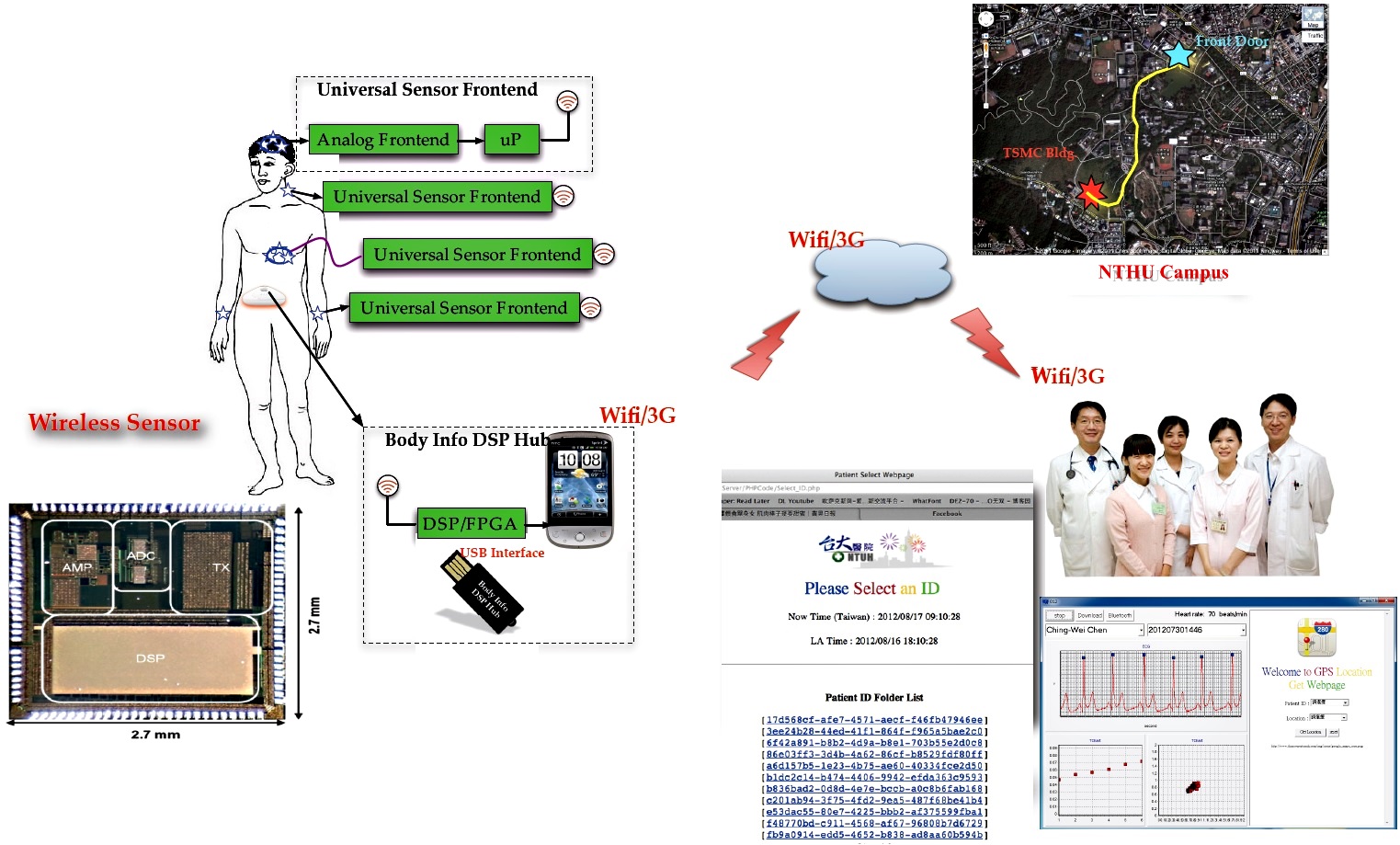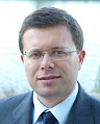A Patient-Centric Medical Environment
By Hsi-Pin Ma, Hung-Chih Chiu, Yi-Lwun Ho, and Yen-Hung Lin
A platform for acquiring and analyzing ECG data from mobile patients has been developed, using a smartphone as the patient’s gateway device. Using a single-lead ECG, abnormalities such as arrythmias and tachycardia can be detected at the server.
A Patient-centric medical environment is an important trend recently. Through the scenario, the medical organization can provide seamless healthcare services for patients. The environment can save time for going to hospital, improve patients’ life quality, and reduce the abuse cost for medical treatment. An example platform to provide mobile healthcare with electrocardiogram (ECG) is developed[[1,2]. Figure 1 presents the scenario. The platform uses a smartphone as a mobile gateway to transmit the recorded ECG data wirelessly back to the cloud server: Bluetooth for data from ECG sensor to the smartphone, while 3G or Wi-Fi for data from the smartphone to the cloud server. Furthermore, the platform can also provide outdoor positioning using global positioning system (GPS) and indoor localization using Wi-Fi technology[3]. In addition, the server in the cloud can automatically analyze recorded ECG signal in more detail with accurate and advanced algorithms. For instance, the discrete wavelet transform (DWT)[4] can be used to reduce the noise in the recorded ECG data and enhance the R peak detection[5]. When ECG features are detected, other algorithms such as time-frequency analysis, Hilbert Huang transformation (HHT), multi-scale entropy, and de-trended fluctuation analysis can be applied for further analysis. This can provide valuable information for physicians[6].

Figure 1: Patient-centric medical environment.
In this platform, a single-lead ECG delineation system based on the DWT has been developed[5]. DWT is very important to get the parameters of ECG signal clear without noise[[7-9]. In this platform, we can use the wavelet coefficients to process the ECG signal to analyze the signal at different resolution levels. The block diagram of the proposed method is shown in Figure 2.

Figure 2: The block diagram for the proposed algorithm.
The wavelet transform is used to decompose the raw ECG signal that the Symlets wavelets (sym5) and soft-thresholding are chosen as the wavelet function and thresholding method to do noise correction at the first denoising stage. The second stage can then remove baseline, sEMG and motion artifact (MA) noise based on the according levels. The third stage is R wave detection and QS detection (using search window based on R peak). By the Q and S peaks, we can detect the onset and offset of the QRS complex with algorithms such as zero crossing, maximum and minimum in different situations. Finally, we reconstruct signal to remove high frequency interference and then use the threshold and adaptive searching window to detect P and T waves. The ECG signal is decomposed up to series of levels until level 8. According to the QRS complex characteristics, which can be identified from level 2 to 5. The frequency for the three levels is from 5.625Hz to 62.5Hz, so the effect of baseline wander can be eliminated. To determine the threshold, the position of maximum value in the window is adopted. We traced 5 seconds forward to obtain the second maximum value. Consequently, the result could be fixed better, since the error rate of finding R peak was still too high. The average value of RR interval can be used as a reference and update it by the most-resent eight RR intervals. The MIT- BIH arrhythmia database is used to verify proposed algorithm. The algorithm for R wave detection has a sensitivity of 99.70% and a positive predictivity of 99.65%. The error rate is 0.65% under all kinds of situation (0.37% if ignoring 3 worst cases). In addition, the SNR improvement is achieved at least 10dB at SNR 5dB for noise correction, and most of the improvement SNR are better than other methods at least 1dB at different SNR. We have also demonstrated that all R peaks can be detected no matter when people walk, run or move at the speed below 9km/hr. The performance of delineation on the QT database (QTDB) shows that our algorithm can achieve high sensitivity of detecting ECG features annotated by cardiologists. The QRS detector attains a sensitivity of Se over 99.94%, while detectors of P and T waves achieve Se = 99.75% and Se = 99.7%, respectively.
According to these features, possible symptoms can be inferred. Heart rate can help detect cardiovascular abnormalities like sinus bradycardia and sinus tachycardia. Abnormal length of PR interval could represent occurrence of A-V Block. As for the QT interval (QTc), it can indicate the probability of the occurrence of arrhythmia. Therefore, the overall status of heart can be acquired through these features.
Acknowledgements This work was supported by National Program for Intelligent Electronics, Taiwan and NTU-NTUH-MediaTek Innovative Medical Electronics Research Center.
For Further Reading
1. C. C. Chan, C. W. Chen, W. C. Chou, Y. L. Ho, Y. H. Lin, and H. P. Ma, “Live Demonstration: A Mobile ECG Healthcare Platform,” in Biomedical Circuits and Systems Conference (BioCAS), 2012 IEEE, 2012, pp. 87-87.
2. C. C. Chan, W. C. Chou, C. W. Chen, Y. L. Ho, Y. H. Lin, and H. P. Ma, “Energy Efficient Diagnostic Grade Mobile ECG Monitoring,” in New Circuits and Systems Conference (NEWCAS), 2012 IEEE 10th International, 2012, pp. 153-156.
3. C. H. Lu, H. H. Kuo, C. W. Hsiao, Y. L. Ho, Y. H. Lin, and H. P. Ma, “Localization with WLAN on Smartphones in Hospitals,” IEEE 14th International Conference on e-Health Networking, Applications and Services, 2013.
4. S. G. Mallat, “A Theory for Multiresolution Signal Decomposition: the Wavelet Representation,” Pattern Analysis and Machine Intelligence, IEEE Transactions on, vol. 11, pp. 674-693, 1989.
5. H. Y. Lin, S. Y. Liang, Y. L. Ho, Y. H. Lin, and H. P. Ma, “Discrete-Wavelet-Transform-Based Noise Reduction and R Wave Detection for ECG Signals,” IEEE 14th International Conference on e-Health Networking, Applications and Services, 2013.
6. Y. C. Liu, C. S. Hung, Y. W. Wu, Y. C. Lee, Y. H. Lin, C. Lin, M. T. Lo, C. C. Chan, H. P. Ma, Y. L. Ho, and C. H. Chen, “Influence of Non-Alcoholic Fatty Liver Disease on Autonomic Changes Evaluated by the Time Domain, Frequency Domain, and Symbolic Dynamics of Heart Rate Variability,” PLoS ONE, vol. 8, p. e61803, 2013.
7. A. K. Ziarani and A. Konrad, “A Nonlinear Adaptive Method of Elimination of Power Line Interference in ECG Signals,” Biomedical Engineering, IEEE Transactions on, vol. 49, pp. 540-547, 2002.
8. Z. Donghui, “Wavelet Approach for ECG Baseline Wander Correction and Noise Reduction,” in Engineering in Medicine and Biology Society, 2005. IEEE-EMBS 2005. 27th Annual International Conference of the, 2005, pp. 1212-1215.
9. M. Blanco-Velasco, B. Weng, and K. E. Barner, “ECG Signal Denoising and Baseline Wander Correction Based on the Empirical Mode Decomposition,” Computers in Biology and Medicine, vol. 38, pp. 1-13, 1// 2008.
Contributors
 Hsi-Pin Ma is an Associate Professor of Department of Electrical Engineering at National Tsing Hua University, Hsinchu, Taiwan. He received his Ph. D. from National Taiwan University, Taipei, Taiwan. His research interests include communications system design and SoC implementation, power efficient/energy efficient signal processing, and biomedical signal processing and system applications. Website: http://www.ee.nthu.edu.tw/~hp/ Read more
Hsi-Pin Ma is an Associate Professor of Department of Electrical Engineering at National Tsing Hua University, Hsinchu, Taiwan. He received his Ph. D. from National Taiwan University, Taipei, Taiwan. His research interests include communications system design and SoC implementation, power efficient/energy efficient signal processing, and biomedical signal processing and system applications. Website: http://www.ee.nthu.edu.tw/~hp/ Read more
 Hung-Chih Chiu is a Ph. D. student in the National Tsing Hua University since 2011. His research interests include biomedical signal processing and Very-large-scale integration (VLSI). He received the master degree at National Central University in 2010. Read more
Hung-Chih Chiu is a Ph. D. student in the National Tsing Hua University since 2011. His research interests include biomedical signal processing and Very-large-scale integration (VLSI). He received the master degree at National Central University in 2010. Read more
 Yi-Lwun Ho MD. PhD., is an associate professor of Department of Internal Medicine and also an adjunct associate professor of Graduate Institute of Clinical Medicine, National Taiwan University (NTU) College of Medicine. He is a cardiologist and specialized in electro-physiologic studies of arrhythmia. One of his research emphases has been in telecare of cardiovascular diseases. He also used linear and non-linear analysis of heart rate variability to study the predictors of patients with heart failure. He is the Director of Heart Failure Center of NTU Hospital. He is also the Director of Tele-Health Center of NTU Hospital. Read more
Yi-Lwun Ho MD. PhD., is an associate professor of Department of Internal Medicine and also an adjunct associate professor of Graduate Institute of Clinical Medicine, National Taiwan University (NTU) College of Medicine. He is a cardiologist and specialized in electro-physiologic studies of arrhythmia. One of his research emphases has been in telecare of cardiovascular diseases. He also used linear and non-linear analysis of heart rate variability to study the predictors of patients with heart failure. He is the Director of Heart Failure Center of NTU Hospital. He is also the Director of Tele-Health Center of NTU Hospital. Read more
 Yen-Hung Lin MD, PhD is clinical assistant professor of Internal Medicine at National Taiwan University College of Medicine and attending physician of Department of Internal Medicine at National Taiwan University Hospital. Dr. Lin received his MD degree in School of Medicine, National Taiwan University and his PhD degree in Graduate Institute of Clinical Medicine, School of Medicine, National Taiwan University. His research interests focus on cardiac and vascular function and structure change in primary aldosteronism, and biomarkers in various cardiovascular disease, including hypertensive heart disease, coronary artery disease, and heart failure Read more
Yen-Hung Lin MD, PhD is clinical assistant professor of Internal Medicine at National Taiwan University College of Medicine and attending physician of Department of Internal Medicine at National Taiwan University Hospital. Dr. Lin received his MD degree in School of Medicine, National Taiwan University and his PhD degree in Graduate Institute of Clinical Medicine, School of Medicine, National Taiwan University. His research interests focus on cardiac and vascular function and structure change in primary aldosteronism, and biomarkers in various cardiovascular disease, including hypertensive heart disease, coronary artery disease, and heart failure Read more







 Joel José P. C. Rodrigues (S'01, M'06, SM'06) is a professor in the Department of Informatics of the University of Beira Interior, Covilhã, Portugal, and researcher at the Instituto de Telecomunicações, Portugal. He received a PhD degree in informatics engineering from the University of Beira Interior. His main research interests include sensor networks, e-health, e-learning, vehicular delay-tolerant networks, and mobile and ubiquitous computing.
Joel José P. C. Rodrigues (S'01, M'06, SM'06) is a professor in the Department of Informatics of the University of Beira Interior, Covilhã, Portugal, and researcher at the Instituto de Telecomunicações, Portugal. He received a PhD degree in informatics engineering from the University of Beira Interior. His main research interests include sensor networks, e-health, e-learning, vehicular delay-tolerant networks, and mobile and ubiquitous computing.  Hsi-Pin Ma is an Associate Professor of Department of Electrical Engineering at National Tsing Hua University, Hsinchu, Taiwan. He received his Ph. D. from National Taiwan University, Taipei, Taiwan. His research interests include communications system design and SoC implementation, power efficient/energy efficient signal processing, and biomedical signal processing and system applications.
Hsi-Pin Ma is an Associate Professor of Department of Electrical Engineering at National Tsing Hua University, Hsinchu, Taiwan. He received his Ph. D. from National Taiwan University, Taipei, Taiwan. His research interests include communications system design and SoC implementation, power efficient/energy efficient signal processing, and biomedical signal processing and system applications.  Hung-Chih Chiu is a Ph. D. student in the National Tsing Hua University since 2011. His research interests include biomedical signal processing and Very-large-scale integration (VLSI). He received the master degree at National Central University in 2010.
Hung-Chih Chiu is a Ph. D. student in the National Tsing Hua University since 2011. His research interests include biomedical signal processing and Very-large-scale integration (VLSI). He received the master degree at National Central University in 2010.  Yi-Lwun Ho MD. PhD., is an associate professor of Department of Internal Medicine and also an adjunct associate professor of Graduate Institute of Clinical Medicine, National Taiwan University (NTU) College of Medicine. He is a cardiologist and specialized in electro-physiologic studies of arrhythmia. One of his research emphases has been in telecare of cardiovascular diseases. He also used linear and non-linear analysis of heart rate variability to study the predictors of patients with heart failure. He is the Director of Heart Failure Center of NTU Hospital. He is also the Director of Tele-Health Center of NTU Hospital.
Yi-Lwun Ho MD. PhD., is an associate professor of Department of Internal Medicine and also an adjunct associate professor of Graduate Institute of Clinical Medicine, National Taiwan University (NTU) College of Medicine. He is a cardiologist and specialized in electro-physiologic studies of arrhythmia. One of his research emphases has been in telecare of cardiovascular diseases. He also used linear and non-linear analysis of heart rate variability to study the predictors of patients with heart failure. He is the Director of Heart Failure Center of NTU Hospital. He is also the Director of Tele-Health Center of NTU Hospital.  Yen-Hung Lin MD, PhD is clinical assistant professor of Internal Medicine at National Taiwan University College of Medicine and attending physician of Department of Internal Medicine at National Taiwan University Hospital. Dr. Lin received his MD degree in School of Medicine, National Taiwan University and his PhD degree in Graduate Institute of Clinical Medicine, School of Medicine, National Taiwan University. His research interests focus on cardiac and vascular function and structure change in primary aldosteronism, and biomarkers in various cardiovascular disease, including hypertensive heart disease, coronary artery disease, and heart failure
Yen-Hung Lin MD, PhD is clinical assistant professor of Internal Medicine at National Taiwan University College of Medicine and attending physician of Department of Internal Medicine at National Taiwan University Hospital. Dr. Lin received his MD degree in School of Medicine, National Taiwan University and his PhD degree in Graduate Institute of Clinical Medicine, School of Medicine, National Taiwan University. His research interests focus on cardiac and vascular function and structure change in primary aldosteronism, and biomarkers in various cardiovascular disease, including hypertensive heart disease, coronary artery disease, and heart failure  E. Kartsakli received her PhD in Wireless Telecommunications from the Technical University of Catalonia (BarcelonaTECH) She has participated in several national and European projects. Her research interests include wireless networking, channel access protocols and energy efficient communication protocols.
E. Kartsakli received her PhD in Wireless Telecommunications from the Technical University of Catalonia (BarcelonaTECH) She has participated in several national and European projects. Her research interests include wireless networking, channel access protocols and energy efficient communication protocols.  Angelos Antonopoulos received his Ph.D. from Technical University of Catalonia (UPC). He is currently working as a Post-Doctoral Researcher at the Smart Energy Efficient Communication Technologies (SMARTECH) area of the Telecommunications Technological Centre of Catalonia (CTTC) and his main research interests include cooperative communications, MAC protocols, network coding and energy efficient network planning.
Angelos Antonopoulos received his Ph.D. from Technical University of Catalonia (UPC). He is currently working as a Post-Doctoral Researcher at the Smart Energy Efficient Communication Technologies (SMARTECH) area of the Telecommunications Technological Centre of Catalonia (CTTC) and his main research interests include cooperative communications, MAC protocols, network coding and energy efficient network planning.  Stefano Tennina received the Ph.D. degree in Electrical and Information Engineering from the University of L'Aquila, Italy. He is co-founder of WEST Aquila s.r.l. with the role of Senior Research Scientist. His research interests focus is in the area of wireless communication protocols/systems, with particular emphasis on experimentation activities in real working networks test-beds.
Stefano Tennina received the Ph.D. degree in Electrical and Information Engineering from the University of L'Aquila, Italy. He is co-founder of WEST Aquila s.r.l. with the role of Senior Research Scientist. His research interests focus is in the area of wireless communication protocols/systems, with particular emphasis on experimentation activities in real working networks test-beds.  Aris S. Lalos received the Ph.D. degree in signal processing for wireless communications from the Computer Engineering and Informatics Department (CEID), School of Engineering (SE), University of Patras (UoP), Rio-Patras, Greece. He is currently a Postdoctoral Fellow at signal theory and communication department, Technical University of Catalonia, Barcelona, Spain.
Aris S. Lalos received the Ph.D. degree in signal processing for wireless communications from the Computer Engineering and Informatics Department (CEID), School of Engineering (SE), University of Patras (UoP), Rio-Patras, Greece. He is currently a Postdoctoral Fellow at signal theory and communication department, Technical University of Catalonia, Barcelona, Spain.  Prodromos-Vasileios Mekikis holds a Master of Science in System on Chip design from Royal Institute of Technology (KTH) He is currently pursuing a PhD degree at the Signal Theory and Communications department (TSC) of the Technical University of Catalonia (UPC). His main research interests include cooperative communications and large scale wireless sensor networks.
Prodromos-Vasileios Mekikis holds a Master of Science in System on Chip design from Royal Institute of Technology (KTH) He is currently pursuing a PhD degree at the Signal Theory and Communications department (TSC) of the Technical University of Catalonia (UPC). His main research interests include cooperative communications and large scale wireless sensor networks.  Luis Alonso received the PhD from UPC (Barcelona) He is an Associate Professor at UPC. He is co-founder of the Wireless Communications and Technologies Research Group (WiComTec). His current research interests are within the field of medium access protocols, radio resource management, cross-layer optimization, cooperative transmissions, cognitive radio and QoS features for all kind of wireless communications systems.
Luis Alonso received the PhD from UPC (Barcelona) He is an Associate Professor at UPC. He is co-founder of the Wireless Communications and Technologies Research Group (WiComTec). His current research interests are within the field of medium access protocols, radio resource management, cross-layer optimization, cooperative transmissions, cognitive radio and QoS features for all kind of wireless communications systems.  Fabio Graziosi received the Ph.D. degree in electronic engineering from the University of L'Aquila, Italy. He is the Chairman of the Board of Directors of WEST Aquila s.r.l.. He is also an Associate Professor at the University of L'Aquila, Italy. His current research interests are mainly focused on wireless communications systems with emphasis on wireless sensor networks.
Fabio Graziosi received the Ph.D. degree in electronic engineering from the University of L'Aquila, Italy. He is the Chairman of the Board of Directors of WEST Aquila s.r.l.. He is also an Associate Professor at the University of L'Aquila, Italy. His current research interests are mainly focused on wireless communications systems with emphasis on wireless sensor networks.  Marco Di Renzo received the Ph.D. degree from the University of L'Aquila, Italy. He received the H.D.R. degree from the University of Paris-Sud XI, France. He is a faculty member of the Laboratory of Signals and Systems, a joint laboratory of CNRS, SUPELEC and the University of Paris-Sud XI, France.
Marco Di Renzo received the Ph.D. degree from the University of L'Aquila, Italy. He received the H.D.R. degree from the University of Paris-Sud XI, France. He is a faculty member of the Laboratory of Signals and Systems, a joint laboratory of CNRS, SUPELEC and the University of Paris-Sud XI, France.  Christos Verikoukis received his Ph.D. from the Technical University of Catalonia. He is currently the Head of the SMARTECH department at CTTC and he is an adjunct associate professor in the area of ICT for Healthcare at Barcelona University (UB).
Christos Verikoukis received his Ph.D. from the Technical University of Catalonia. He is currently the Head of the SMARTECH department at CTTC and he is an adjunct associate professor in the area of ICT for Healthcare at Barcelona University (UB).